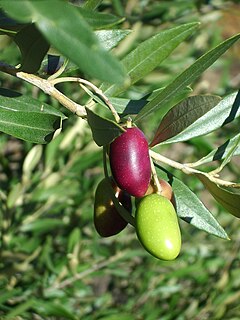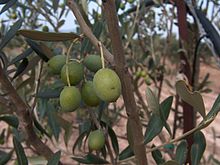
The olive, botanical name Olea europaea, meaning 'European olive' in Latin, is a species of small tree or shrub in the family Oleaceae, found traditionally in the Mediterranean Basin. When in shrub form, it is known as Olea europaea 'Montra', dwarf olive, or little olive. The species is cultivated in all the countries of the Mediterranean, as well as in Australia, New Zealand, North and South America and South Africa. Olea europaea is the type species for the genus Olea.

Arbequina is a cultivar of olives. The fruit is highly aromatic, small, symmetrical and dark brown, with a rounded apex and a broad peduncular cavity. In Europe, it is mostly grown in Catalonia, Spain, but it is also grown in Aragon and Andalusia, as well as California, Argentina, Chile, Australia and Azerbaijan. It has recently become one of the dominant olive cultivars in the world, largely under highly intensive, "super high-density" plantation.
Empeltre is a type of medium-sized, black olive originating in Spain. It is used both as a table olive and to produce a high-quality olive oil.

The Lucques is a cultivar of olives grown primarily in Languedoc in France. It is primarily used as a green table olive. It can also produce high quality oil, but this is hard to extract. Though vulnerable to certain pests, it is relatively resistant to cold and drought.

The Aglandau is one of the more important of approximately a hundred cultivars of olives in France. It is grown primarily in Provence, but also as far away as Azerbaijan and Ukraine. The 'Aglandau' is primarily used for production of oil, but can also be eaten. When used as table olives, the fruit is normally called Beruguette. The oil is highly valued for its fruity taste.
The Salonenque, carrying the name of Salon-de-Provence, is a cultivar of olives grown primarily in Provence. Though it is used for producing oil, and gives a good yield, it is valued primarily as a table olive. It is produced as a so-called cracked olive, which means that the fruit is cracked to speed up the curing process.

The Picholine is a French cultivar of olives. It is the most widely available cultivar in France. Though originally from Gard in southern France, it is today grown all over the world. The Picholine is best known as a cocktail olive, though it is also used to make olive oil. It is the most common variety of olive used for oil from Morocco.
The Olivière is a cultivar of olives grown primarily in the Pyrénées-Orientales region of southern France, where it is the most prevalent variety of olives. It is highly valued for its exceptionally high tolerance to cold. The Olivière is primarily used for oil, and even though the fruit yields a low percentage, the trees carry large quantities of olives, and the oil is of high quality.

The Tanche, probably the best known French olive cultivar, is grown primarily in the Drôme and Vaucluse regions of southern France. It is often referred to as a perle noire, the "Black Pearl of Provence". The Tanche is said to have been introduced to France by the Greeks of Massilia, around the fourth century BC.
The Bouteillan is a cultivar of olives grown primarily in Provence. Originally from the town of Aups in the Var département, it is today grown also in Australia and the United States. It is mostly used for the production of oil. The Bouteillan is vulnerable to certain pests, but has a good resistance to cold.

The Cailletier, also known in English by the Italian name Taggiasca, is a cultivar of olives grown primarily in the Alpes-Maritimes region near Nice and the Riviera di Ponente, Italy. It is best known under the name Niçoise, which signifies its curing method. It is commonly used as an important ingredient in the salade niçoise. It can also be used for the production of oil. This cultivar is particularly susceptible to the olive fruit fly.

The Grossane is a cultivar of olives grown primarily in the Vallée des Baux and Bouches-du-Rhône regions of southern France. Though it can be used to produce oil, it is primarily used as a black table olive. Vulnerable to certain biological pests, it is highly resistant to cold and drought.
The Germaine, also Ghjermana, Ghermana, Germana, and sometimes as Romana, is a cultivar of olives grown primarily in Corsica, but also in parts of northern Italy. Genetically it is close to the cultivar Frantoio, that is grown in the Italian region of Tuscany. The Germaine has a good yield of oil, and the plant is resistant to cold weather.

The Sabine is a cultivar of olives grown primarily in Corsica. In the Balagne region of Haute-Corse it is the main variety. The olive yields an exceptionally high amount of oil; more than 30%. Vulnerable to certain biological pests, it is relatively tolerant of cold. The Sabine olive variety should not be confused with the olive oil produced in the Sabina region of Italy.
The Cayon is a cultivar of olives grown primarily in the Var region of southern France. It is used primarily for the production of olive oil. The Cayon is highly valued for its role as a pollinator of other olive varieties.
The Nera di Arbus, more fully Pecora Nera di Arbus, is a breed of small domestic sheep indigenous to the Mediterranean island of Sardinia, Italy. It takes its name from the comune of Arbus, in the province of Medio Campidano, in the south-western part of the island. It is raised in the provinces of Cagliari, Nuoro, Oristano and Sassari. The breed achieved official recognition in 2008.
Verdale-de-l'Hérault is an olive cultivar developed in the department of Hérault, in the southern French region of Occitanie. The fruit produces a sweet oil with a light and fruity aroma of greenery, nuts, and apple, and exhibits no bitterness.

Ascolano is a cold-hardy table variety olive cultivar from the Marche and Tuscany regions of Italy that is also grown in California for olive oil.

Manzanilla olives ("man-zah-nee-ya") or Manzanillo, also Manzanilla de Sevilla, originally from the area of Seville, Spain, are sometimes referred to as Spanish olives but along with Arbosana, Arbequina, Cacereña, Hojiblanca, Empeltre, and Gordal there are over two hundred varieties grown in Spain as well as other areas.













